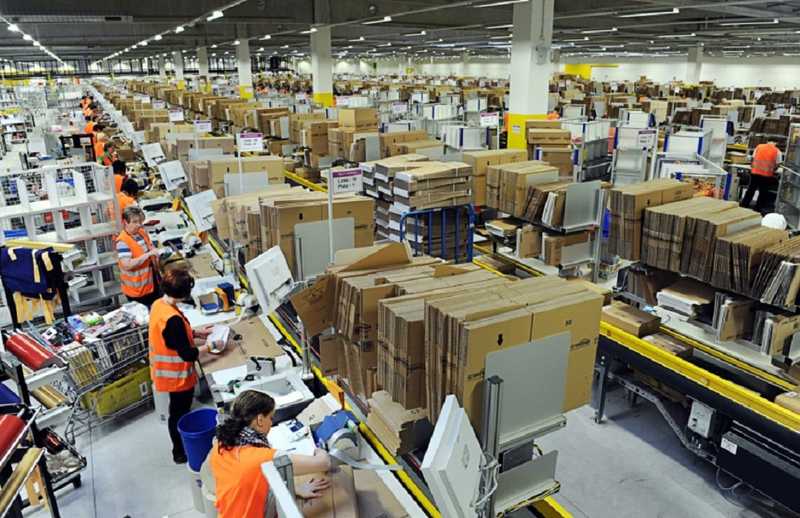On a cool morning in April 2013 over a thousand workers outside the small town of Bad Hersfeld in central Germany took an action of global significance. Armed with whistles and high-visibility vests, members of the general union Ver.di set up a picket line outside an Amazon fulfillment centre – company nomenclature for its massive processing and distribution hubs – marking the first strike in Amazon’s history.
Today, that most confected and bemusing of late capitalism’s holidays – “Black Friday” – yet again draws attention to Amazon and its labour practices. Whilst US workers in Alabama make a bold attempt to unionise, Progressive International has launched a global campaign to #MakeAmazonPay. Yet for two decades numerous unions and campaigns across the globe have scratched their heads wondering how to curb the ever-expanding might of what has become one of the world’s most valuable companies.
At Bad Hersfeld and (eventually) internationally, Amazon has become far more accustomed to strikes, yet the company’s power shows no signs of being tempered. Indeed in Germany, despite more than 300 days lost to strike action, Amazon has consistently been able to resist workers’ demand for a collective agreement. In the UK, initial attempts to organise workers by the Graphical, Paper and Media Union (ultimately merged into Unite) were effectively seen off by Amazon back in 2001, and while recent attempts by the GMB general union, revolving around the call “Amazon Workers Are Not Robots”, have proved to have more sticking power, the union admits it has a long way to go.
“We won some incremental changes as well for a short time on payments. We have also saved people’s jobs, who may have been unfairly treated,” says Mick Rix, a national officer at GMB. “So yes we have made some slight differences, but there is more to do, especially reducing the amount of accidents and injuries.” Rix also points to the union’s role in challenging Amazon’s “lacklustre approach” to Covid-19, yet the goal of a recognition agreement – a key priority for enabling negotiation over pay and conditions – remains a long way off.
Indeed, it seems that everywhere, Amazon marches on largely unencumbered. Consider the sheer scale of the multi-billion dollar company; its world-beating service, which was drafted in to assist Covid-19 test deliveries; its worker-beating patents; its AI operation, assisted by over 100 million Alexa devices quietly listening in people’s actual homes; its unparalleled market dominance over cloud computing – is it any wonder even the company’s name has now all but supplanted a two million square mile rainforest in the popular imagination?
However you cut it, Amazon presents a challenge to the entire project of the left – from those who merely want a say on workers’ pay to those who would like to see Amazon’s immense infrastructure repurposed to serve the public good, and indeed those who would like to see the back of the company altogether. Both Amazon’s scale and its significance to the very infrastructure of modern web and retail industries mean its influence has the potential to be era-defining, which makes it a crucial political problem for us to navigate collectively.
A culture of control
There aren’t many unions that don’t have concerns about Amazon. But while its attitude towards workers, their livelihoods and their safety is notoriously poor, a less-discussed cause for concern is that Amazon just seems so damn impenetrable. Whatever unions seem to throw at it, they seem resigned to organising largely from the outside whilst Amazon develops its own organising strategies at a far greater pace and scale, leading the way in both algorithmic management techniques and, certainly for its delivery drivers, flexible working practices which leave workers disempowered and disposable.
It isn’t that Amazon isn’t concerned about unions. Its use of openly anti-union propaganda – particularly in the US – is widely documented, and recently Amazon was forced to defend its recruitment of intelligence operatives for the purpose of tracking “labour organising threats” – an inaccurate description of the role, the company says. But Amazon’s hatred of unions comes less from the substance of what any particular union has demanded so far, and rather from the company’s absolute insistence on the total control of its workplaces, work processes, and workforce.
Enter many staff areas at Amazon and you will learn about the company ethos – contestation is welcome, even encouraged, as long as it is done the Amazon way. This entails using company work councils and staff reps to raise concerns, or providing feedback about how the flow of goods could be further improved during one of management’s daily “gemba walks” – a lap of the production line aimed at spotting inefficiencies, before ironing them out with a “kaizen”. Kaizen – a concept from Japanese management theory meaning “continuous improvement” – has been appropriated by Amazon to mean any waste-saving activity. Employees who rack up “kaizens” may be viewed favourably by managers or featured on the company website.
Amazon’s application process similarly illustrates a culture of total control. Enroll for an Amazon job at an agency recruitment centre and between the induction video, one-to-one interview and on-the-spot drug test, you’ll be handed a tablet device loaded with a timed questionnaire – a sort of morality test – to be taken in your native language to ensure the authenticity of your responses to questions about the appropriate action to take if you become aware a colleague is stealing, or the ethics of speaking to journalists about your work. At pains to point out the questionnaire is the one element of the process the agency has no control over – results are sent directly to Amazon for evaluation – the agency will stress Amazon is looking for your honest answer, and that only opting for “model” answers will only look suspicious (“we are all human, after all”).
Resigned to the outside?
Faced with such a totalitarian ethos, it’s understandable that many look to legislators to rein Amazon’s excesses in. But so far parliamentarians have shown little interest in Amazon specifically, and although short-lived inquiries into the future of work commonly acknowledge that there’s something unsettling about the direction of travel in the working practices of companies that rely heavily on the data processing capacities of ever more sophisticated digital technologies, parliamentarians almost always settle on matters of employment security rather than conditions at work.
Similarly common among unions, the logic of this “precarity preoccupation” supposes that “fixing” flexible, temporary, atypical or outright bogus employment practices in e-commerce and the gig economy would ensure workers are getting their piece of the pie, as if having a permanent contract would do much to empower workers who are forced to walk 11 miles a shift or pack up to 200 parcels an hour for 55 hours a week. This is before we get to the not insignificant issue of local councils – including those run by Labour – frequently bending over backwards to accommodate Amazon with publicly funded access roads and planning permission in the name of job creation, often while simultaneously citing vague “concerns” about the types of jobs Amazon actually creates.
If looking to legislators doesn’t inspire confidence, it is reasonable that people look to the organised labour movement for direction. It’s no secret that in most parts of the world, the UK included, unions have been out in the cold for two decades when it comes to Amazon, forced to try to recruit members from the outside, such as by placing ads in local newspapers. We can blame the UK’s aggressive anti-union laws for the obstacles unions face, but there are other issues at play. Any union’s strategy will involve getting a foot in the door with the workforce by taking up casework for individual workers, with a longer-term plan of forcing recognition from the employer, whether statutory or voluntary, yet Amazon’s reliance on a high-turnover temp workforce – typically employed through third party agencies – to supplement its core staff presents barriers to ever securing anything approaching union density.
It’s little wonder, then, that media campaigns have become such important tactics to unions, both for recruitment and attempting to “shame” Amazon, especially given journalistic exposés have had some purchase in at least making the public more aware of life behind the warehouse walls. Yet such a heavy reliance on waging the air war against Amazon points to a weakness of any campaign’s ability to actually organise Amazon workers, and while such tactics may deliver partial wins on specific issues, it’s unclear to what extent they can really be understood to build power for the workers whose work is vital to the effective operation of the world’s most powerful company.
Rather, what we are witnessing is a major disparity between the political tools at our disposal for holding Amazon to account and the way its power is actually organised in the workplace. Amazon’s approach to “continuous improvement” is to iron out potential sources of friction wherever they occur in the supply chain, meaning it is likely the company will only become harder to organise as it continues to develop and grow. See, for example, the massive expansion of Amazon Flex over the last few years – the company’s gig-style platform for Prime deliveries, which has massively reduced the company’s reliance on external (and better unionised) firms such as Royal Mail. In this context, it would be wishful thinking to imagine Amazon’s future development will move closer towards organisational forms that would suit unions’ historic organising repertoire.
Algorithmic power
It should be clear by now that for all the flashy videos of workerless factory floors populated by zippy robots that do the rounds on social media from time to time, Amazon’s technological strategy in fulfillment centres looks more like the algorithmically-micromanaged subjugation of relatively poorly paid workers than assembly lines full of expensive robots, and will continue to do so for some time. With fulfillment centres generally located out of town and near to major road networks rather than urban centres, it’s no coincidence that Amazon prefers to base its logistical operations either in formerly industrial areas with high unemployment.
But Amazon’s power over workers is not merely social and economic. What leaves tired workers “feeling like robots” is the technical power of the company’s productive processes. Indeed, it should be impossible to have a conversation about Amazon’s treatment of its workers without talking about the company’s pioneering use of algorithmic management and its effect on the mere possibility of shop-floor organising.
Take the work of a picker – someone whose job is to collect items from randomly-stored shelf stacks – on the basis of instructions from a handheld radio data terminal which doubles up as a scanner. Items are allocated to the worker one at a time based on the worker’s last known location in order to optimise the route taken between items. The scanner can display a timer, indicating the time the worker should take to find and scan each item – generally around 12 seconds – at which point a new item instruction is pushed to the device. Contrary to popular misconception, the towers in which pickers generally work should not be crammed full of workers if they are functioning smoothly – on the contrary, the optimal scenario for the algorithmic system is that workers never cross paths or get in each other’s way. The result is that working for Amazon can be incredibly lonely, each worker trapped in a succession of 12-second missions over the course of a lengthy shift, all striving to meet performance targets which are by many workers’ accounts either unachievable or unsustainable.
In her influential study of machine gambling, Natasha Dow Schüll noted how the design features of repetitive screen-based information technologies produce the “zone” or “flow” effects familiar to habitual gamblers. Amazon workers similarly experience temporal and psychosocial dislocation, but there is a further power imbalance produced by the informational asymmetry of the algorithmic management system. Algorithmic management is rooted in Taylorist management principles, which are defined by a fundamental separation between the conception (ideas, planning) of work and its execution by workers. Its roots are in the organisational theories of Frederick Winslow Taylor, an industrial engineer at the turn of the 20th century who advocated the conversion of workers’ traditional know-how into discrete tasks, which could be deskilled and calculated according to time, breaking skilled workers’ natural power over the work process by putting the sphere of the organisation and planning of work into managers’ hands. If this sounds arcane and technical, consider the frustrations of Deliveroo riders who feel themselves to be “slaves to the algorithm”, continually put in the position of trying to second-guess a complex algorithmic management system which operates in ways they are beholden to yet cannot control or influence.
The frontier of control
Tackling the processual (or “protocological”) power that keeps Amazon workers disempowered and demoralised day-to-day means asserting some claim over how work is actually done in Amazon’s workplaces. Amazon’s political will in this area is well-documented, and it’s a reality we will have to reckon with if we’re serious about workers no longer being “treated like robots”. But this is historically tricky ground for unions, which have long preferred to consider questions of organisation and technology the prerogative of bosses, as long as they don’t directly entail job losses. The question of how workers (and therefore work) should be organised within workplaces therefore raises the question of what in 1920 Carter L. Goodrich called the “frontier of control” – the fault line that runs through workplaces dividing that which the union may stake a claim on from the sphere of managerial control, within which workplaces matters are regarded as “the employer’s business alone”.
When Goodrich was writing, the demand for workers’ democratic control of workplaces was still present in the left’s vocabulary, even if it was not the preferred goal of trade unions, which opted for a more collaborative relationship with employers wherever possible. Over the course of the 20th century, trade unions across the anglophone world have largely settled into a fairly limited range of priorities where collective bargaining is concerned: jobs, terms of employment (pay and entitlements), and pensions. In the 1970s the point was well-articulated by Harry Braverman:
“The unionized working class, intimidated by the scale and complexity of capitalist production, and weakened in its original revolutionary impetus by the gains afforded by the rapid increase of productivity, increasingly lost the will and ambition to wrest control of production from capitalist hands and turned ever more to bargaining over labor’s share in the product.”
Braverman also detailed how the idea of a more collaborative relationship within management led to a fundamental ambivalence about the techniques of deskilling, organisation of the labour process, and technologies used to govern workers on a daily basis. Nowadays, where unions do raise their voices on the latter, it is almost solely with respect to health and safety legislation rather than on the grounds of power or even human dignity. The purpose of raising these limitations is neither to bash unions (which, in addition to being legally neutered, as frequently under-resourced) nor to engage in wishful thinking that unions might alternatively become vanguards of working-class power within society any time soon. But the implication of Aaron Benanav’s argument in his new book Automation and the Future of Work is that unions can no longer rely on the idea of “sharing the gains” of workplace technologies in an economic context of stagnant productivity. Any meaningful movement towards a different world of work, he argues, must instead foreground the necessity of actually conquering production for workers.
Taking on an empire
There is no single terrain we could choose to fight Amazon on which would unlock all the other ways the company maintains its grip on workers. However, it is in our interest to broaden our understanding of Amazon’s methods of enacting its power because doing so can, in turn, broaden our understanding of what counter-power might look like. If we accept it is futile to merely wish Amazon were some other, more conventional and conveniently organised workplace, then it is incumbent on the left – from unions to social movements and (we live in hope) parties – to set about strategising ways to loosen Amazon’s grip and accept we will need to expand our organising repertoire in the process. It will not be enough to simply do what we’ve already done over and over again as if one of the world’s most valuable companies will lose a battle of attrition.
Sooner or later, however, we will have to reckon with how work is organised within Amazon, both to assert a claim over the content of the work and to deal with the fact that the organisation of workers inside fulfillment centres is a huge obstacle to building power on the shop floor. This will involve better understanding how algorithmic management both organises work and rearranges social and power relations, and subverting the informational asymmetry that currently ensures workers are disempowered and disposable, including becoming reacquainted with dormant labour movement tactics such as slowdowns or purposefully disrupting the labour process. Evidently, such an undertaking would be akin to waging a guerrilla war against an empire. But Amazon isn’t the type of problem that can simply be fixed.
Craig Gent is the head of operations at Novara Media.
Photo: Scott Lewis / Flickr




